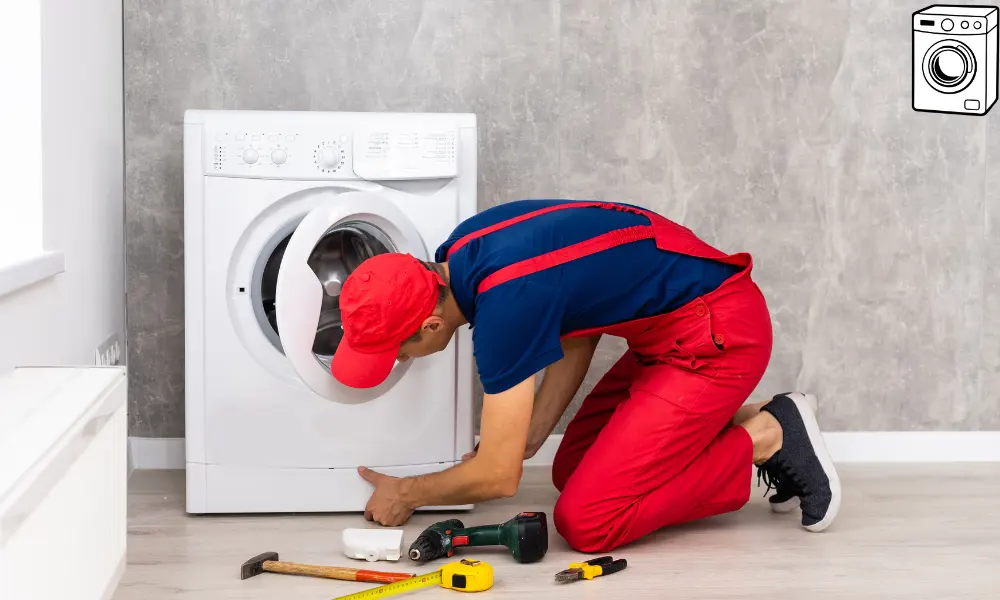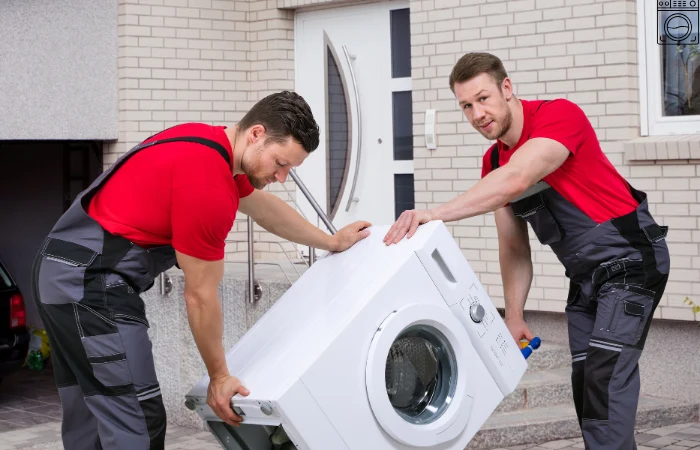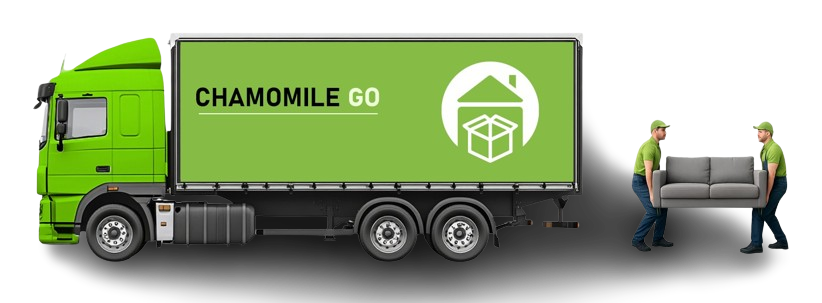Moving a washing machine might look simple, but it requires careful preparation and the right steps to avoid damage or injury. Washing machines are heavy, contain delicate parts, and are connected to both water and electrical lines so improper handling can lead to costly repairs or accidents. Before you start, it’s important to prepare the area, protect your floors, and ensure you have the right moving tools to make the process safe and smooth.
If you’ve ever wondered how do you move a washing machine safely, this guide will walk you through everything you need to know. From disconnecting hoses and draining water to loading it onto a dolly and securing it in your moving truck, each step is designed to protect your appliance and your home. You’ll also learn when it’s best to call professional movers for help, especially if you’re moving long-distance or handling multiple heavy appliances.
Five Steps to Take Before Moving a Washing Machine

Before you start moving a washing machine, proper preparation is key to preventing damage and ensuring safety. Follow these five simple steps to get your washer ready for a smooth and hassle-free move.
Step 1: Unplug and Disconnect Water Supply Lines
- Turn off the power from the wall socket to keep things safe.
- Shut off the hot and cold water valves connected to the washer.
- Gently disconnect both hoses and keep a towel or bucket ready to catch leftover water.
- This prevents spills and electrical hazards before moving a washer.
Step 2: Drain All Remaining Water
- Completely drain water from the hoses and drum using a small pan or towel.
- This avoids leaks and keeps your floors clean and dry.
- Always double-check that no water is left inside the washer.
Step 3: Secure the Drum Using Transit Bolts
- Insert the transit bolts (usually provided with your machine) into the back of the washer.
- These bolts keep the drum from moving or getting damaged during transport.
- Check your user manual if you’re unsure how to install them correctly.
Step 4: Clean and Dry the Washing Machine
- Wipe down both the inside and outside of the machine.
- Leave the door open for a few hours to air-dry and prevent mold.
- A clean and dry washer is safer and easier to handle during a move.
Step 5: Gather the Right Moving Equipment
- Use a moving dolly, lifting straps, moving blankets, and strong packing tape.
- Wear non-slip shoes and protective gloves for extra safety.
- Having the proper tools ensures that moving a washing machine is secure and damage-free.
How Do You Move a Washing Machine for Moving in Five Easy Steps
Once your washer is properly prepared, it’s time to move it safely. Knowing how to move a washing machine without damage takes teamwork, the right tools, and careful handling. Follow these five easy steps to ensure your moving a washer and dryer process goes smoothly and safely.
Step 1: Protect the Floor and Pathway
- Lay down cardboard sheets or moving mats to prevent scratches or dents on the floor.
- Clear the path from your laundry area to the moving vehicle.
- A clean and protected path ensures a smooth and safe move for your washing machine.
Step 2: Tilt and Lift the Washing Machine Safely
- Always ask for help — never lift the machine alone.
- Bend your knees, keep your back straight, and lift with your legs, not your back.
- Tilting the washer slightly backward can make it easier to position on the dolly.
- These steps prevent injury and protect the appliance while moving a washer and dryer.
Step 3: Load the Washing Machine onto a Dolly
- Slide the dolly under the washer carefully, keeping the appliance upright.
- Use strong moving straps to secure the washer firmly to the dolly.
- Ensure the weight is balanced before you start rolling it toward the moving truck.
Step 4: Transport Carefully to the Moving Vehicle
- Move slowly and keep the washer upright throughout the process.
- Avoid sudden tilts or jerks that can damage the drum or internal parts.
- If there are stairs, have one person guide while the other supports the weight from below.
- Staying cautious during this step is crucial when you move washing machine units safely.
Step 5: Secure the Washing Machine in the Truck
- Once inside the truck, place the washer against a stable wall.
- Use straps or ropes to tie it securely, preventing any movement during transit.
- Avoid placing heavy items on top of the machine.
- Keeping it stable ensures your moving a washer and dryer job is safe until unloading.
You may read How To Make Moving Less Stressful?
When to Require Professional Movers
While moving a washing machine yourself can save money, some situations call for expert help. If the task feels too heavy, risky, or time-consuming, hiring professionals can make all the difference. Knowing when to reach out to a trusted Sherman Oaks moving company ensures your appliance stays safe and your move goes smoothly.
1. When the Appliance Is Large or Heavy
Front-load washers are typically heavier than top-load ones because of their design and internal drum. If your washing machine is large, bulky, or difficult to maneuver, professional movers have the right tools and experience to handle it safely. They know how to lift, balance, and transport it without damaging the floor or appliance.
2. When You Lack Proper Equipment or Assistance
Moving a washing machine requires dollies, moving straps, and protective blankets. If you don’t have these, it’s best not to risk injury or property damage. A Sherman Oaks moving company like Chamomile Go comes fully equipped with all the necessary tools and manpower to move heavy appliances efficiently.
3. When You’re Moving Long Distance or Upstairs
Handling stairs, tight hallways, or long-distance moves adds extra challenges when relocating large appliances. Professionals are trained to manage such obstacles safely and are insured in case of any mishaps. Hiring experts ensures your washing machine reaches its new location without a scratch or strain on your back.
4. How Professional Movers Help
Professional movers save you time, effort, and stress. They use proven techniques to protect your washer during loading, transport, and unloading. At Chamomile Go, your trusted Sherman Oaks moving company, we specialize in moving appliances safely and efficiently across Los Angeles and nearby areas. If you want your washing machine moved without hassle, contact our local moving team today for reliable and affordable service.
Conclusion
Learning how do you move a washing machine safely comes down to preparation, teamwork, and the right equipment. By following each step carefully, you can protect both your appliance and your home from damage. But if the task feels too heavy or complex, professional help is just a call away. Chamomile Go, your trusted Sherman Oaks moving company, is here to make your move easy, safe, and stress-free. Contact us today for expert appliance moving services anywhere in Los Angeles!
FAQs
Can One Person Move A Washing Machine Alone?
It’s not recommended to move a washing machine alone. These appliances are heavy and awkward to lift, which can cause injuries or damage. Always have at least one other person help or hire professional movers for safety.
Do I Need To Drain My Washer Before Moving It?
Yes. Always drain all remaining water from the hoses and drum before moving your washer. This prevents leaks, mold growth, and water damage during transport.
How Do You Move A Washing Machine Without Transit Bolts?
If you don’t have transit bolts, you can cushion the drum with towels or soft padding to minimize movement. However, using transit bolts is the safest option, so check if replacements are available for your model before moving.
Can I Lay My Washing Machine On Its Side While Moving?
It’s best to keep the washer upright during the move. Laying it on its side can damage internal components or cause the drum to misalign. Always transport it vertically if possible.
How Do You Move A Washing Machine Upstairs Or Downstairs?
When moving a washing machine on stairs, use a sturdy appliance dolly and straps. Always have one person guide from above and another support from below. For tight stairways, it’s best to hire professionals.








